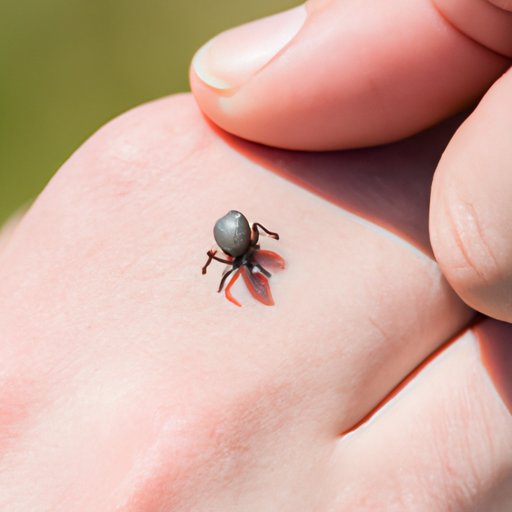Introduction
Ticks are small insects that latch onto the skin of animals and humans to feed on blood. Although they are usually not harmful, they can transmit diseases such as Lyme disease. Therefore, it is essential to know how to properly remove them from the body. This article will provide a comprehensive guide on how to remove ticks safely and effectively.
7 Simple Steps to Safely Removing Ticks from Your Body
The safest way to remove a tick is to use tweezers. Follow these seven simple steps:
- Use fine-tipped tweezers to grasp the tick as close to the skin’s surface as possible.
- Pull upward with steady, even pressure. Do not twist or jerk the tick to avoid leaving its mouthpart in the skin.
- After removing the tick, clean the bite area with rubbing alcohol or soap and water.
- Do not crush the tick with your fingers. Dispose of it in a sealed plastic bag or container, or flush it down the toilet.
- If you experience symptoms such as fever, rash, or body aches after a tick bite, seek medical attention immediately.
- Record the date of the tick bite and monitor your symptoms. This information will be helpful if you need to seek medical attention later.
- Continue to watch for signs of infection such as swelling or redness around the bite area. Seek medical attention if these symptoms occur.
Natural DIY Methods for Tick Removal
Several natural ingredients can help to remove ticks. Here are some natural remedies:
- Essential oils: Tea tree oil, lavender oil, and eucalyptus oil can be used to repel and kill ticks. Mix a few drops of your preferred oil with water in a spray bottle and apply it to exposed skin.
- Peppermint oil: Peppermint oil can also be used to repel ticks. Add a few drops to a cotton ball and apply it to exposed skin.
- Diatomaceous earth: Sprinkle diatomaceous earth around areas where ticks may live, such as yards and gardens. This powdery substance dehydrates ticks, causing them to die.
- Tick tubes: Tick tubes are cardboard tubes filled with permethrin-treated cotton. Place them around your yard to kill ticks.
It is important to note that natural remedies may not be as effective as traditional methods and should not be used as a substitute.
What to Do and What Not to Do When Removing Ticks
When removing ticks, it is important to avoid certain mistakes that can lead to infection or incomplete removal:
- Do not use petroleum jelly, gasoline, or any other substances to try to remove ticks. This can cause the tick to regurgitate, increasing the risk of disease transmission.
- Do not try to burn the tick or use a hot match to remove it. This method is not effective and can cause injury.
- Do not use your fingers to remove the tick. This increases the likelihood of leaving its mouthpart in your skin.
- Do not dispose of the tick in the trash. It may crawl out and attach itself to someone else.
Always use tweezers to remove ticks and follow the seven steps outlined earlier. Seek medical attention if you experience any symptoms after the tick bite.
Expert Advice: The Best Tools and Techniques for Tick Removal
There are several tools available for tick removal, and each has its advantages and disadvantages:
- Tweezers: Fine-tipped tweezers are the most effective tool for removing ticks. They can grab the tick’s mouthpart without squeezing its body.
- Tick removal tool: Tick removal tools are designed to remove the tick without squeezing or crushing its body. They work by sliding between the tick’s mouthpart and the skin.
- Tick key: A tick key is a small plastic tool that can be used to remove ticks. It works by inserting the key into the tick’s mouthpart and twisting it off.
When using any of these tools, remember to follow the seven steps outlined earlier.
Preventing Tick Bites and Proper Tick Removal Techniques
Preventing tick bites is the most effective way to avoid tick-borne diseases. Here are some prevention strategies:
- Wear long-sleeved shirts and pants when outdoors.
- Use insect repellent that contains DEET or other effective ingredients.
- Stay on trails and avoid walking through tall grass or brush.
- Perform a tick check after spending time outdoors.
- Shower within two hours of coming indoors to wash off any unattached ticks.
If you find any ticks, follow the seven steps outlined earlier to remove them safely and effectively.
Conclusion
Removing ticks is crucial for preventing tick-borne diseases. Follow the seven steps for removing ticks safely and effectively using tweezers, and wash the bite area after removal. Natural remedies can be used in addition to traditional methods but should not replace them. Avoid common mistakes like using your fingers or petroleum jelly and seek medical attention if necessary. Choose the best tool for your needs, and finally, focus on preventing tick bites through proper clothing and insect repellent use.
